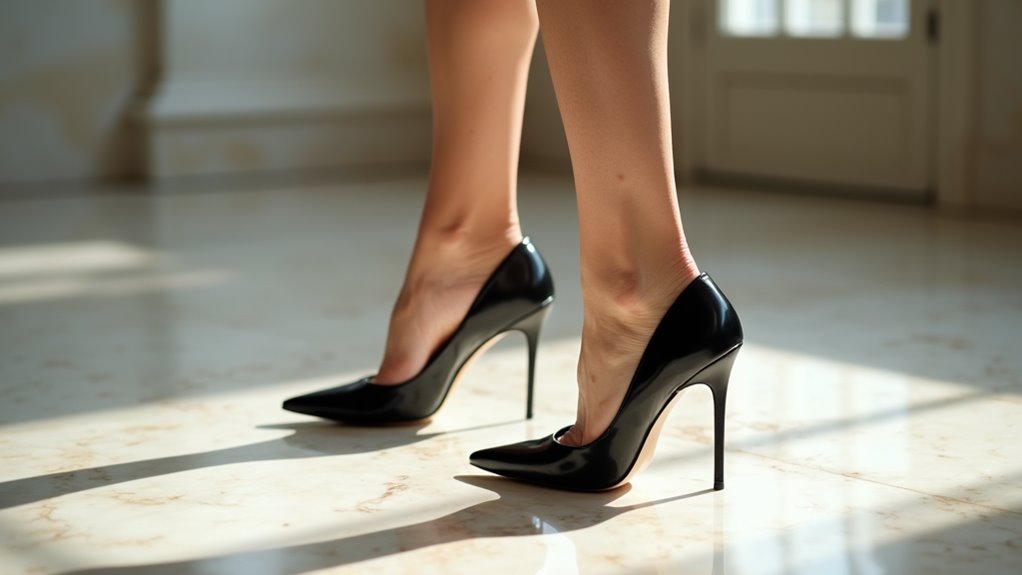There may be products. Products are independently selected by our editors. We may earn an affiliate commission from the links with no charge to you, example: as Amazon Affiliate.
Like Cinderella discovering her glass slipper could change her life, you’ll find that mastering high heels can transform your confidence and presence. Whether you’re navigating corporate boardrooms or social gatherings, the ability to walk gracefully in heels isn’t just about fashion—it’s about commanding respect and moving with purpose. You’ll need more than just practice to achieve that enviable stride; it’s a combination of understanding biomechanics, building core strength, and learning proper technique. If you’ve ever wobbled in your favorite stilettos or felt uncertain about tackling those three-inch heels, you’re about to discover the secrets that separate the novices from the experts.
Key Takeaways
- Land heel-first, roll through to toes, and keep knees slightly bent while walking to maintain optimal balance and control.
- Engage your core muscles continuously and maintain upright posture with shoulders back and neck aligned.
- Strengthen ankle stability through regular calf raises and ankle rotation exercises before wearing high heels regularly.
- Choose shoes with proper arch support and cushioned footbeds, limiting wear time to three hours maximum.
- Practice walking techniques by visualizing a straight line and distributing weight evenly across the entire foot.
Understanding Basic Heel Mechanics
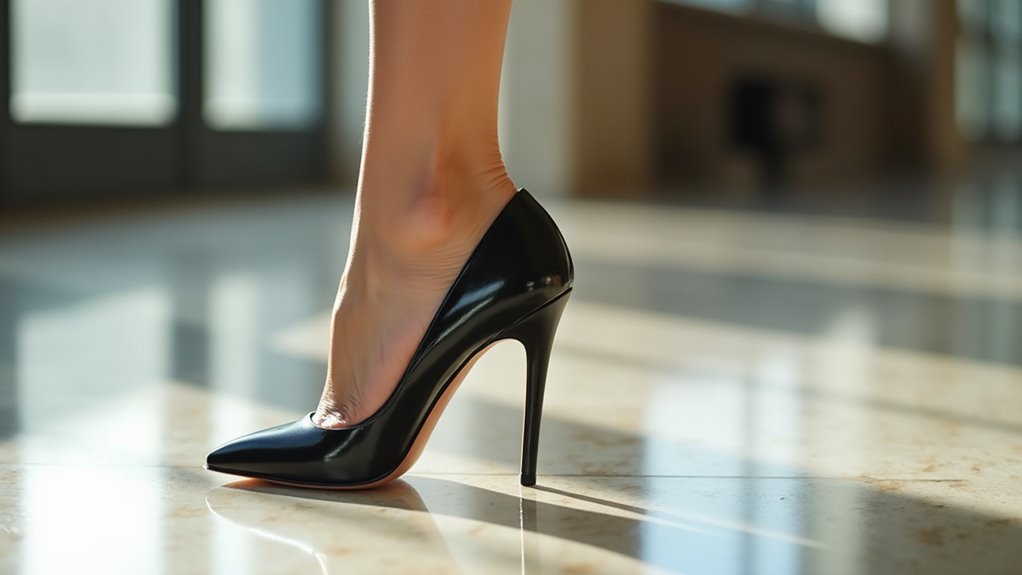
The mechanics of high heels create a complex chain reaction throughout your body’s structure. When you wear high heels, your center of mass shifts upward and forward, forcing your body to compensate. This compensation triggers increased lumbar lordosis and heightened trunk muscle activity, which can lead to back fatigue and discomfort.
Your feet experience significant changes too. The elevated heel position increases pressure on your forefoot and causes greater foot supination.
You’ll notice altered movement patterns in both your forefoot and hindfoot compared to flat shoes. The raised heel also affects your ankle joint, creating a reduced internal moment while increasing varus and valgus forces at your knee.
Understanding these mechanics is crucial because they directly impact your balance, stability, and overall posture when wearing heels.
Choosing Your Perfect Heel
Finding your perfect pair of heels involves more than just picking a style you love – it’s about striking the right balance between comfort, stability, and fashion.
Start by measuring your feet at day’s end when they’re slightly swollen, and don’t hesitate to try multiple sizes since brands can vary. For optimal stability, stick to heels under 6 centimeters, especially if you’ll be standing for long periods.
Wide heels and platforms offer better weight distribution and support.
Look for shoes with built-in arch support and cushioned footbeds. If you have wider feet, opt for styles with rounded or almond-shaped toes. Consider adding gel inserts for extra comfort, and don’t forget to match your heel choice to the occasion – lower heights work best for extended wear, while classic pumps suit formal events.
For maximum comfort during formal occasions, choose formal heels with cushioned insoles and breathable materials that allow your feet to move naturally.
Posture Alignment Essentials

Maintaining proper posture in high heels requires understanding how these shoes fundamentally alter your body’s alignment. When you wear high heels, your lumbar spine flattens, your pelvis tilts backward, and your head and thoracic spine shift posteriorly.
These changes force your body to compensate, creating tension in your calf, hip, and back muscles. To achieve optimal alignment, focus on keeping your weight evenly distributed and your core engaged.
You’ll need to strengthen your gluteal muscles and maintain hip mobility to counteract postural imbalances. Consider using orthopedic inserts for additional support, and don’t exceed three hours of continuous wear.
If you’re wearing heels regularly, incorporate daily stretching exercises targeting your calves, hips, and back muscles to prevent musculoskeletal issues and maintain healthy posture. For maximum stability and comfort while dancing, choose dance-specific footwear designed with proper support and flexibility.
Strengthening Your Core Support
Your core strength forms the foundation for confident high heel wear, so you’ll need to engage your abs daily through exercises like the Single-Leg Stretch and Stability Ball Dead Bug.
Perfect your pelvic tilt by practicing the Shoulder Bridge and Half Roll Back to maintain proper alignment between your spine and pelvis.
You can build strong back muscles through dynamic exercises like the Marching Glute Bridge and Forearm Plank with Toe Taps, which work together to create a stable support system for your body.
Engage Your Abs Daily
A strong core serves as the foundation for mastering high heel balance.
You’ll find that daily core engagement not only improves your stability but also reduces back pain while wearing heels.
Focus on controlled movements and keep your back flat during exercises to activate your deepest core muscles.
- Feel empowered as you strengthen your core with heel touches and reverse crunches
- Build confidence through single leg bridges that enhance your balance
- Experience greater stability with alternating supine heel taps
- Transform your posture by mastering the quadruped position
Treat your core like any other major muscle group and aim to engage it at least three times weekly.
Remember to draw your belly button toward your spine and maintain proper form throughout each exercise to maximize results.
Perfect Your Pelvic Tilt
Proper pelvic alignment stands at the heart of confident heel-wearing. When you’re in heels, your pelvis naturally tilts forward, which can strain your lower back and affect your posture.
To counter this, you’ll need to master the posterior pelvic tilt.
Start by practicing the basic posterior tilt exercise: lie on your back, bend your knees, and flatten your lower back against the floor while engaging your abs. Once you’ve mastered this, progress to bridge exercises that strengthen both your core and back muscles.
Don’t forget to stretch your hip flexors daily, as tight hip muscles can worsen pelvic tilt.
When walking in heels, focus on forefoot placement rather than heel strikes. This technique helps maintain better pelvic alignment and reduces the stress on your lower back.
Build Strong Back Muscles
While mastering high heels requires pelvic control, building strong back and core muscles creates the foundation for confident walking.
Your stability ball can become your best ally in developing these essential muscles through exercises like crunches and Russian twists that target your core strength.
- Feel empowered as you hold a perfect plank position, knowing each second strengthens your foundation.
- Experience the satisfaction of mastering the bird dog pose, enhancing your balance and coordination.
- Build confidence as your core grows stronger through consistent leg lifts.
- Notice the graceful ease of movement as your improved posture turns heads.
Remember to maintain controlled movements and progress gradually.
Combine these exercises with hip flexor and glute strengthening moves to create a comprehensive routine that supports your high heel journey.
Safe Walking Techniques
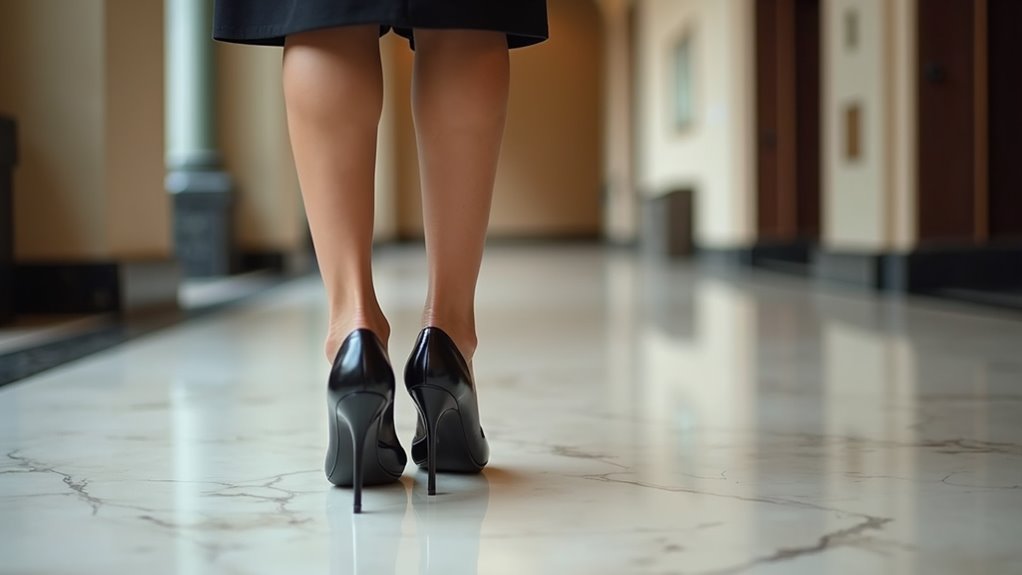
Learning to walk safely in high heels requires mastering fundamental techniques that prioritize balance and control.
Start by landing on your heel and rolling forward to your toe, keeping your strides shorter than you’d take in flat shoes. You’ll want to slightly bend your knees when landing to protect your back and maintain stability.
As you walk, imagine you’re on a balance beam to help keep your steps aligned.
Don’t try to speed up by taking longer steps – instead, increase your steps per minute while maintaining proper form.
Keep your body tension high but your lower muscles relaxed, and engage your glutes for movement rather than swaying your hips.
Remember to maintain good posture by keeping your back straight and your abdominals engaged throughout your stride.
Choosing comfort-focused heels can significantly improve your walking stability and confidence.
Preventing Common Heel Injuries
Even with perfect walking technique, high heels can pose significant injury risks to your feet, ankles, and legs. To protect yourself from common injuries like bunions, stress fractures, and arch strain, you’ll need to take preventive measures that go beyond just walking correctly.
- Don’t let fashion override your foot health – stick to heels under 2 inches whenever possible to reduce pressure on your forefoot.
- Your toes deserve breathing room – choose shoes with wider toe boxes to prevent painful deformities.
- Support your feet’s natural structure – invest in quality orthopedic insoles to distribute weight evenly.
- Listen to your body’s signals – limit high heel wear to three hours or less, and strengthen your lower leg muscles through regular exercise.
Consider switching to eco-friendly non-leather heels made from sustainable materials to reduce environmental impact while maintaining style.
When you follow these guidelines, you’ll significantly reduce your risk of developing chronic foot problems while still enjoying your favorite heels.
Practicing Balance Methods
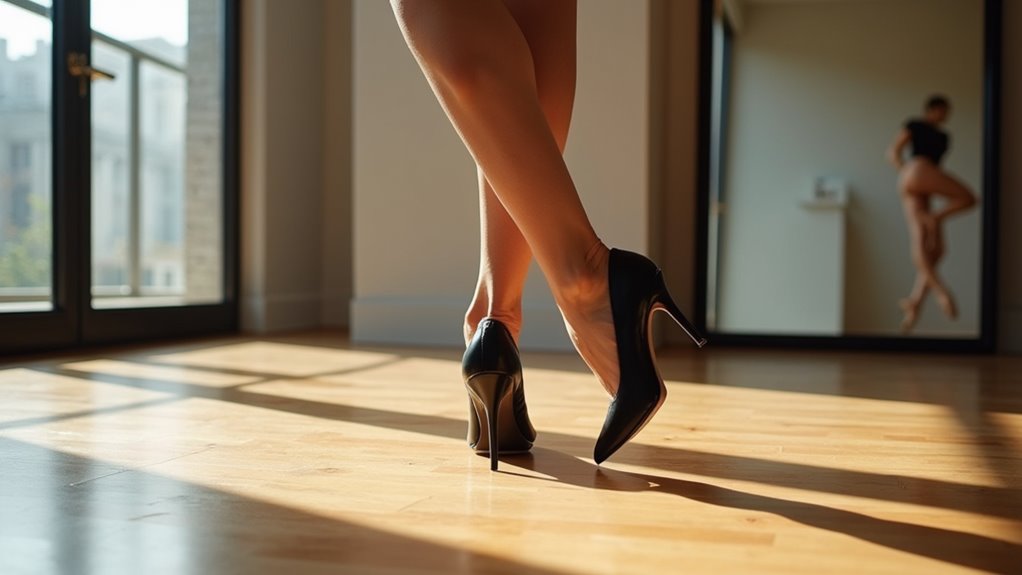
To master walking in high heels, you’ll need to develop proper balance through consistent practice and proven techniques. Start by maintaining proper posture with your shoulders back, neck tall, and core engaged. Practice walking slowly while rolling your foot from heel to toe, and use full-length mirrors to check your form. Glossy red heels provide an elegant, versatile option suitable for practicing these techniques.
| Exercise | Technique | Benefit |
|---|---|---|
| One-Heel Stand | Balance on single heel with support | Builds stability |
| Foot Rolls | Roll feet in/out 3 times each | Warms up muscles |
| Balance Beam | Walk straight line heel-to-toe | Improves alignment |
| Back Walking | Practice reverse heel walking | Enhances coordination |
| Core Activation | Engage abs while walking | Supports stability |
Begin with lower heels and gradually progress to higher ones as your confidence grows. Remember to focus on a fixed point and keep your arms ready for balance assistance.
Building Ankle Stability
Start improving your heel-toe control through deliberate walking exercises that emphasize rolling from heel strike to toe push-off.
You’ll need to strengthen your ankle muscles daily with targeted exercises like calf raises and ankle rotations to build the stability required for high heels.
Using a balance board can significantly enhance your proprioception and ankle control, making you more confident and secure in any heel height.
Consider transitioning to wellness shoes during training sessions to provide optimal support while developing proper foot mechanics.
Focus on Heel-Toe Control
When wearing high heels, mastering heel-toe control becomes essential for preventing ankle injuries and maintaining stability. Your natural walking pattern shifts from heel-toe to toe-heel when wearing heels above 3 inches, requiring careful attention to maintain balance.
To enhance your heel-toe control and protect your ankles, focus on these crucial elements:
- Strengthen your ankle muscles through targeted exercises to prevent painful sprains.
- Practice controlled movements to develop muscle memory and reduce your risk of falls.
- Limit your time in very high heels to avoid chronic ankle instability and muscle tightening.
- Choose shoes with thicker heels and proper cushioning to distribute pressure more evenly.
Remember that while experience improves balance control, maintaining proper form during each step remains critical for long-term stability.
Strengthening Ankle Muscles Daily
A strong foundation of ankle stability begins with daily strengthening exercises that target key muscle groups.
You’ll want to start with basic calf raises, performing two sets of 10 repetitions while keeping your feet hip-width apart and squeezing your quads and glutes.
Progress to single-leg exercises, including one-leg balances and Bosu ball work, to enhance your stability. Hold these positions for 12 seconds, repeating five times per side.
Incorporate ankle rolls and resistance band exercises to improve flexibility and strength in all directions. Don’t forget tibialis exercises like penguin walks, which strengthen the often-neglected muscles at the front of your shin.
Dedicate 10-15 minutes daily to these exercises, combining both standing and seated movements to build comprehensive ankle strength.
Balance Board Training Benefits
Training with a balance board offers powerful benefits for building ankle stability, particularly if you’re working toward mastering high heels. This versatile tool strengthens your ankles, improves your balance, and enhances your body’s ability to sense position and movement – all crucial skills for confidently walking in heels.
- You’ll feel more stable and graceful as your core and ankle muscles become stronger.
- You’ll reduce your risk of ankle sprains and falls when wearing high heels.
- You’ll notice improved posture and better overall body control.
- You’ll experience enhanced coordination and flexibility in your daily activities.
Regular balance board training not only aids in injury prevention but also speeds up recovery if you’re rehabilitating from an ankle injury.
It’s an engaging way to build the foundation you need for comfortable heel wearing.
Professional Movement Tips
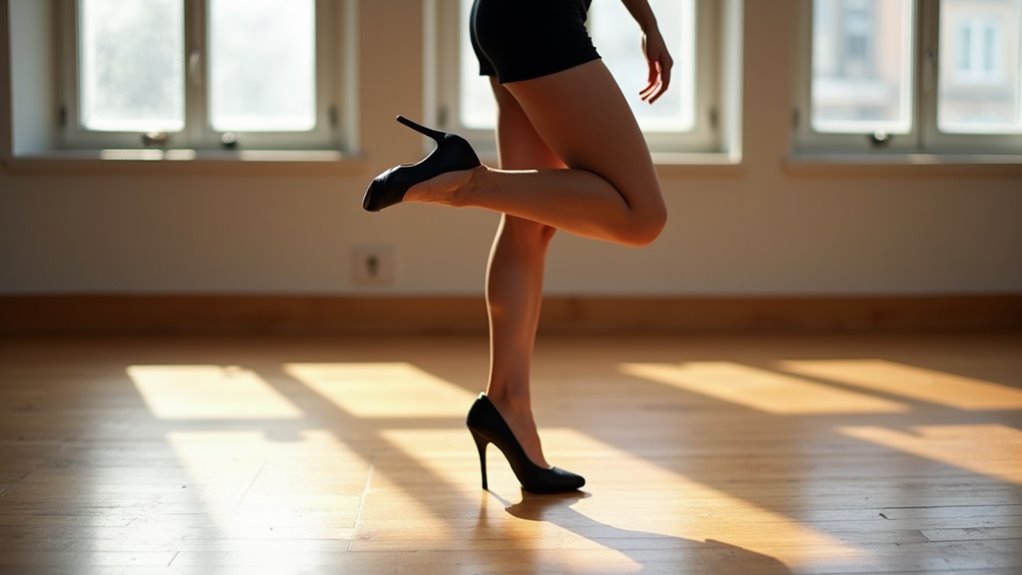
Professional dancers and models glide effortlessly in towering heels because they’ve mastered essential movement techniques.
You’ll need to maintain an upright posture with your chin parallel to the floor and your head aligned with your spine. Keep your shoulders relaxed and let your arms swing naturally at your sides.
When walking, place your heel down first, followed by your toe, and focus on taking slower, deliberate steps in a straight line.
Don’t lock your knees; instead, keep them slightly bent for better balance.
Remember that your center of mass shifts upward in heels, so you’ll need to adjust your weight distribution. The key is to let most of your weight transfer to the lateral part of your foot while engaging your tibialis anterior muscle for stability.
For optimal comfort and stability, consider heels made with natural materials that provide better grip and breathability.
Heel Care and Maintenance
Before you step into your heels, take a quick look at the heel tips, soles, and overall structure to catch any potential issues early on.
You’ll want to wipe down your heels after each wear and store them properly in cotton dust bags with shoe trees to maintain their shape.
Creating a designated space in your closet away from direct sunlight and moisture will help preserve your heels’ quality and extend their lifespan.
Daily Heel Inspection Tips
Three essential steps form the foundation of proper heel maintenance: daily inspections, proper cleaning, and preventive care. Your daily inspection routine should focus on identifying early signs of wear, checking stability, and examining heel attachments for any loosening.
- Start by gently wiping down your heels with a dry microfiber cloth to remove dirt and debris.
- Use a slightly damp cloth in circular motions for stubborn spots, avoiding harsh cleaners that can damage the material.
- Let your heels dry naturally away from direct heat or sunlight.
- Apply a quality heel conditioner to protect and rejuvenate the material.
Don’t forget to regularly inspect hardware and heel tips for damage. If you notice any issues, address them immediately with appropriate repairs or seek professional help for complex problems.
Proper Storage Methods
After mastering daily inspection habits, your next focus should be on proper heel storage to maximize their lifespan.
Use stackable plastic containers and vertical shelf systems to optimize your space while ensuring proper air circulation. You’ll want to group your heels by type and give each pair its own designated spot to prevent scuffs and damage.
Install individual shelves or custom molding for a more organized approach, and don’t forget to utilize hidden storage spaces under your bed or in coat closets to protect shoes from dust and sunlight.
Keep your heels away from moisture-prone areas and rotate them seasonally to maintain their condition.
When storing, always handle your shoes with care and consider using heel savers to extend their longevity.
Conclusion
With consistent practice and proper technique, you’ll master the art of walking confidently in heels. Studies show that 73% of women who regularly wear high heels experience improved balance within just three weeks of implementing targeted strength training. By following these expert tips, maintaining good posture, and focusing on core stability, you’ll transform your heel-wearing experience from challenging to graceful and comfortable.

